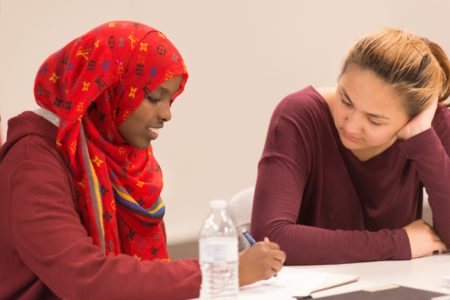
By Matt Halvorson
Summit Sierra High School in Seattle is doing its part to create a school culture that celebrates diversity and actively stands up to racism and discrimination. It starts with teachers and administrators who know that bringing a diverse population of kids into the building is only the beginning of providing a truly equitable education.
As of last school year, Sierra was 43 percent Black/African-American, 24 percent white, 14 percent Asian, 11 percent two or more races, 6 percent Hispanic/Latinx, and 2 percent American Indian/Alaska Native. Of that same group, 47 percent were eligible for free/reduced lunch, and 11 percent were receiving special education services.
“Summit Sierra really reflects the type of diversity that we hope to have — true diversity, both [in terms of] racial background but also economic diversity,” said Abby Cedano, senior director of schools for the Summit network of public charter schools in Washington. “I think we have both of those things here.”
That kind of diversity brings with it a responsibility. For all students to feel truly safe and welcome, it’s not enough to just reject racism in principle. It’s not enough to be aware of the systems that perpetuate our opportunity gaps if we aren’t intentionally working to dismantle them, at least within our own walls.
Summit is living out its active commitment to equity in a number of ways. One of the foundations has been to hire and train culturally competent teachers and staff from a variety of backgrounds, and to help them understand and confront their personal biases.
“We’ve been very intentional about hiring,” Cedano said. “We’re about at 50 percent teachers of color here, which is something we’re really proud of. We try to make sure that our staff reflects our student population as we create these intentionally diverse communities.”
From there, Summit Sierra has carried out ambitious, ongoing training on diversity, equity and inclusion (DEI) for its staff and students.
Back in May, the school held a Race Symposium for all staff and students which was led by Eileen Yoshina, manager of Equity in Education for the Puget Sound Educational Service District.
According to Matt Nelson, academic coach at Summit Sierra, the goals for the symposium were to “build an understanding of the history of race and racism within a shared language, facilitate conversation on current realities, and to expand or reinforce viewpoints on diversity in the local community.”
It was important that staff engage in the training alongside the students, he said, because it “solidifies our commitment to equity, showing by example that this learning is ongoing.”
The day included an interactive presentation on bias touching on a history of segregation, differences between how we present and how we identify, and who “belongs in America.” Participants were encouraged to share personal stories and anecdotes and to ask questions throughout.
The second half included a break-out session where students shifted to their mentor groups to discuss a survey given earlier in the week. Answered anonymously, each student had been asked to describe two experiences: a time when they were discriminated against, and a time when they saw someone else suffering from discrimination.
In small circles, the students read over their classmates’ experiences and then, with mentors facilitating, talked openly and thoughtfully about the impact of discrimination on their lives. They brainstormed ways in which they, the school, and society at large could combat racism before coming back together as a whole school for open mic reflections.
“It was an engaging and fruitful day,” Nelson said.
Additionally, all Summit teachers were trained in culturally responsive classrooms by well-known facilitator Dr. Sharroky Hollie, and follow-ups throughout the year again included the students.
Sierra is also piloting a new college-readiness course this year in an effort to meet the needs of every kid in the building. Because they have a lot of students who will be first-generation college students, the school hired a first-generation college grad who’s been working in college access for many years.
The school doesn’t limit these conversations and intentions to big-picture examples of discrimination either. Just like we as individuals can’t change the world if we haven’t done the internal work to let us live out the values we espouse, an organization or a school can’t expect to be part of the solution when it hasn’t addressed discord and discrimination within its own walls.
So, how does a diverse school manage to live out those values and encourage harmony and cohesion among its students?
One way Summit Sierra cultivates that environment is through mentor groups, which function like old-school “homeroom” classes might have, but with more meat on their bones. The mentor groups integrate students from all different grades, pairing them with a teacher who will stay with the group throughout their high school years.
“With the intentional diversity here, I think mentor groups are really the most powerful piece that allows for that diversity to really thrive, because the mentor groups themselves are intentionally diverse, so when you walk around here at lunch, you see kids hanging out with other kids from their mentor group,” Cedano said. “They tend to form really tight connections, and that means that they’re hanging out with kids from all different backgrounds. I think that structure is one of the reasons that allows the diversity to be really successful, because it’s something we have to intentionally work at, and that structure is pretty powerful.”
In other words, intentional diversity requires ongoing, intentional work to honor all students. Kudos to Summit Sierra for putting its effort where its intentions already live and creating an environment that truly nurtures all its students.
